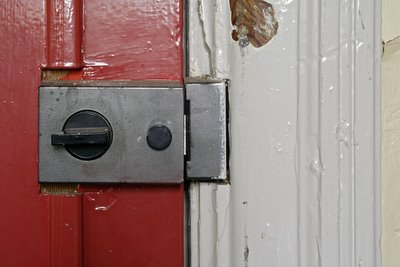Photo Archaeology
 Sometimes I know that when looking at a building I focus too much on the visual drama, or the open vistas or the quality of light. Very important factors, but it is easy to forget the details when you are high on cloud nine gesticulating over that Le Corbusier stairway. I often have to remind myself to slow down and take in the details. They have a lot to say. Let's take the humble door knob for example. That completely utilitarian and functional piece of door furniture can have as much to say about a building, its architect, and its patrons as the more high grade fixtures and fittings. There is a simple beauty about the latch in my photo above which marries form with function. It looks elegant and yet informs as to the possible status of the door.
Sometimes I know that when looking at a building I focus too much on the visual drama, or the open vistas or the quality of light. Very important factors, but it is easy to forget the details when you are high on cloud nine gesticulating over that Le Corbusier stairway. I often have to remind myself to slow down and take in the details. They have a lot to say. Let's take the humble door knob for example. That completely utilitarian and functional piece of door furniture can have as much to say about a building, its architect, and its patrons as the more high grade fixtures and fittings. There is a simple beauty about the latch in my photo above which marries form with function. It looks elegant and yet informs as to the possible status of the door. 
Door furniture can also dilineate spaces in terms of hierarchy. In my local church the porch interior doors have simple clasp fixtures whereas the chancel has the fixture in the photo above (Arts and Crafts by Edgar Wood 1901). As one progresses through the various spaces of the church the door furniture responds to the spiritual hierarchy of the building and is an inherent indicator as to what people thought of the different spaces when the building was built. This is important because a historic buildings original function might be blurred over time. Small details such as door furniture or a particular type of moulding can reveal a lot about the originators. It is particularly useful as an architectural photographer to have this background knowledge because it informs my photography with added understanding and value. One of my greatest pleasures is to photograph a building that has been subject to much re-use over time and with the aid of the lens - strip back the different layers of understanding. I suppose this is a sort of Photo Archaeology!
The door handles above are on the public entrance to the Millenium Building in Cardiff. They have probably been commissioned by an artist? What does it say about the status of the building? Would it be suitable to use such door handles on the toilet doors? Hierarchy plays such an important role. Sometimes the hierarchy or status of a room changes over time and the door fixtures tell you this. 
The door above used to have a rounded brass knob with a classical styling. Now a utilitarian latch type fixture has been added. It has been cut into the existing door moulding. The respect has gone for the overall appearance of the stylistic detailing. Somehow over time the function of this room has changed to something more utilitarian.
The above image was taken at Kilpeck, Herefordshire UK and is the entrance to the Church. So the next time you open a door take your time and take a considered look into the minds of the people that placed it there.


1 comment:
Equisite blog, truely talented individual oozing with potential.
Post a Comment